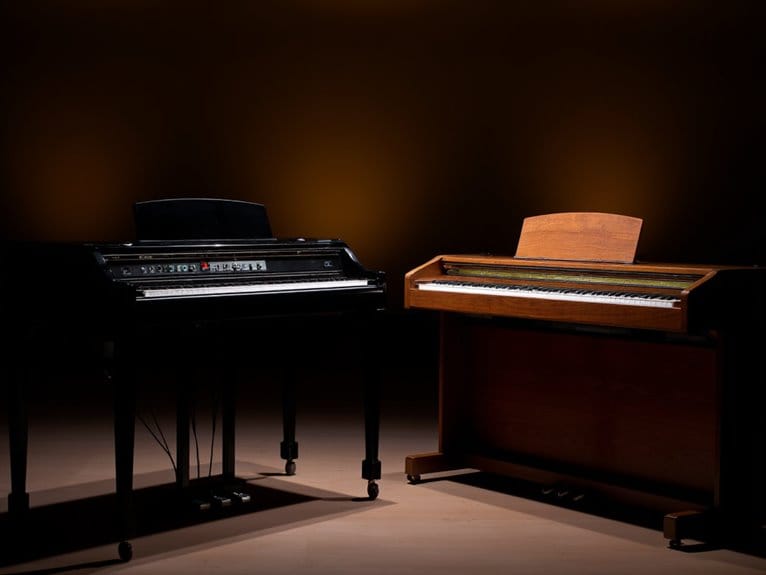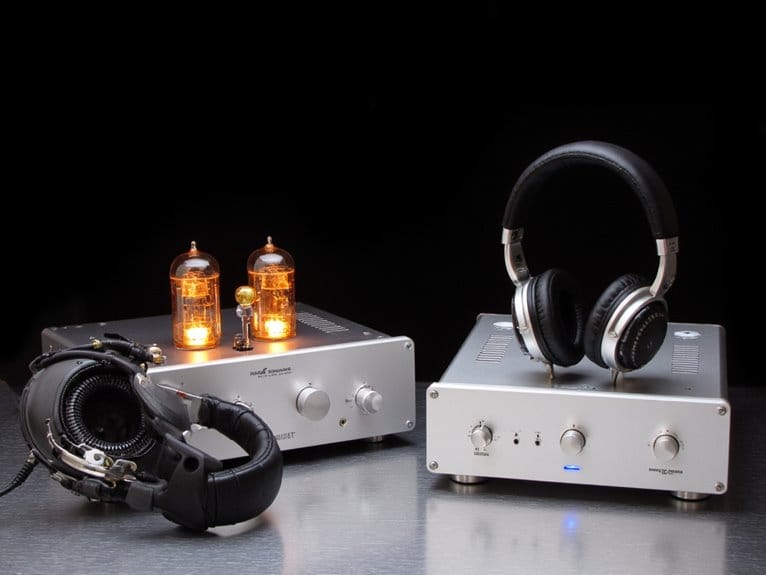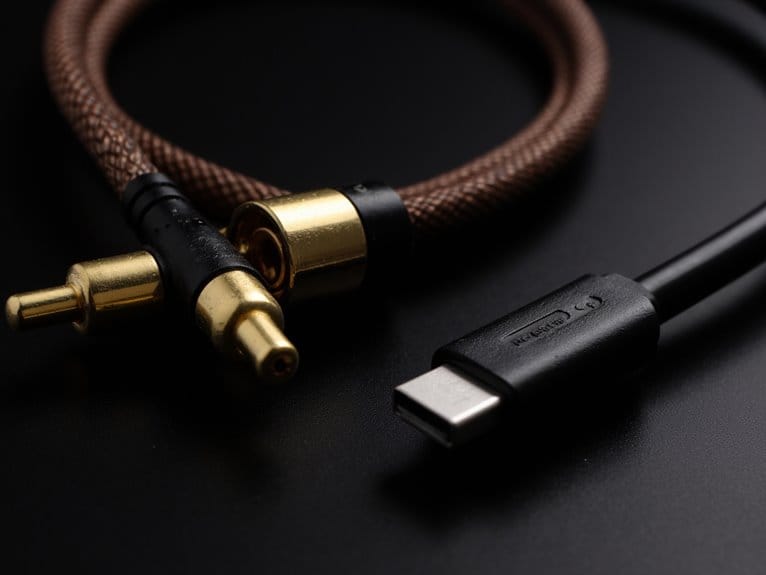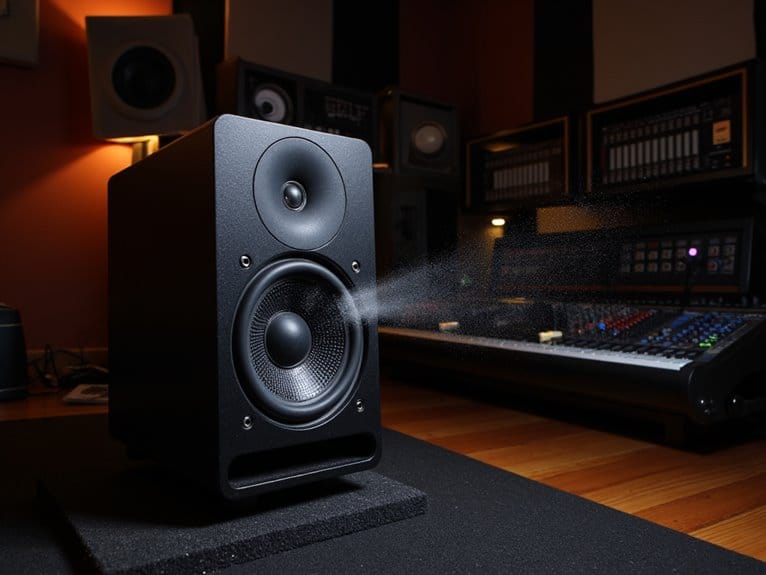Understanding MIDI Keyboards Vs Digital Pianos Vs Synthesizers
MIDI keyboards serve as controllers that send note data to external devices or software, making them ideal for music production and studio work. Digital pianos focus on replicating authentic acoustic piano experiences with 88 weighted keys and internal sound engines, perfect for classical players seeking traditional touch and feel. Synthesizers generate electronic sounds through oscillators and filters, offering extensive real-time sound manipulation for creative experimentation. Each targets different musicians, from producers to pianists to electronic artists, and understanding their unique capabilities will help you choose the right instrument for your specific musical goals.
We are supported by our audience. When you purchase through links on our site, we may earn an affiliate commission, at no extra cost for you. Learn more.
Notable Insights
- MIDI keyboards are controllers that send note data to external devices, while digital pianos and synthesizers generate their own sounds internally.
- Digital pianos focus on replicating authentic acoustic piano sound and feel with 88 weighted keys for traditional piano experience.
- Synthesizers create electronic sounds through oscillators and filters, offering extensive real-time sound manipulation and creative experimentation capabilities.
- MIDI keyboards prioritize portability and production features like knobs, sliders, and assignable controls for DAW integration and studio work.
- Digital pianos target pianists seeking authentic playing experience, while synthesizers attract electronic musicians focused on sound design and experimentation.
Core Functions and Sound Generation Capabilities
Understanding the fundamental differences between these three instrument categories starts with recognizing how each generates or controls sound, a distinction that’ll dramatically affect your musical workflow and creative possibilities.
MIDI keyboards don’t produce sound independently—they’re fundamentally sophisticated controllers that handle signal transmission, sending note data, velocity information, and control messages to external devices or software.
Digital pianos focus entirely on sound production through internal engines, using high-quality samples and modeling to replicate authentic piano timbres with weighted keys that mimic acoustic feel.
Synthesizers take sound production to another level entirely, generating electronic sounds through oscillators, filters, and modulators that enable extensive real-time manipulation. Many modern synthesizers also combine MIDI controller and sound generation functions, allowing musicians to bypass their built-in sounds when using them purely as controllers for external devices. Since synthesizers excel at real-time adjustments, they often feature extensive knobs and sliders for immediate parameter control during performance. Semi-modular synthesizers offer patch points for expanded connectivity and complex signal routing between modules.
While digital pianos excel at piano authenticity and synthesizers offer limitless sonic exploration, MIDI keyboards provide maximum flexibility by controlling whatever sound source you’ve connected. For producers using Ableton Live, many MIDI keyboards offer seamless pre-mapping integration that eliminates the need for manual configuration.
Most modern instruments offer plug-and-play compatibility with popular recording software and DAWs, making integration seamless across different setups.
Physical Design and Portability Factors
When you’re deciding between these instruments, the physical footprint and transportability will likely influence your choice as much as the sound capabilities, since each category takes a markedly different approach to size, weight, and overall design philosophy.
Digital pianos prioritize authentic design aesthetics, featuring 88 weighted keys and substantial builds that mimic acoustic instruments, resulting in heavier units requiring semi-permanent placement.
Digital pianos sacrifice portability for authenticity, delivering concert-quality weighted keys in substantial builds that anchor your musical space.
MIDI keyboards embrace dimension variations from compact 25-key models to full 88-key versions, emphasizing lightweight construction and slim profiles for maximum portability. Modern compact models often include Bluetooth connectivity for wireless streaming and enhanced versatility during practice sessions. Many budget-friendly options feature 61 keys as a compromise between functionality and portability for musicians who need essential range without the full weight of 88-key models.
Synthesizers occupy middle ground with weight differences varying based on complexity, though many prioritize stage-friendly transportation.
Build quality reflects each instrument’s purpose: digital pianos use robust mechanical components for realistic feel, while MIDI controllers favor simplified construction to reduce costs and enhance mobility for traveling musicians. Digital pianos also feature integrated amplifier systems that add to their overall weight compared to MIDI keyboards that rely entirely on external sound sources.
Control Features and Connectivity Options
Beyond the physical characteristics that determine where these instruments fit in your studio or home, the control interfaces and connection capabilities reveal each category’s true purpose and workflow integration potential.
MIDI keyboards excel at control customization, featuring extensive knobs, sliders, and assignable buttons that map directly to your DAW’s transport functions and parameter automation. Their user interface prioritizes flexibility over sound generation, connecting via USB-MIDI and traditional DIN ports without internal audio output. Modern MIDI controllers often include RGB backlit pads and encoders that provide visual feedback for enhanced workflow efficiency in dim studio environments. Most models offer plug-and-play connectivity through USB and Bluetooth, eliminating driver installation requirements across multiple platforms. Professional 88-key MIDI controllers typically include 16 velocity-sensitive pads alongside faders and assignable controls for comprehensive hands-on mixing and production capabilities.
Digital pianos focus on weighted, hammer-action keys with minimal control surfaces, emphasizing realistic piano feel over broad sound shaping.
Synthesizers offer the most thorough control schemes, with extensive real-time parameter manipulation through dedicated knobs, onboard sequencers, and multiple connectivity options including CV/Gate integration.
Target Users and Musical Applications
Since I’ve spent countless hours watching musicians wrestle with the wrong instrument for their needs, I can tell you that understanding each category’s target audience reveals why these instruments evolved so differently.
MIDI keyboards serve music producers who need precise DAW control, live performers requiring real-time manipulation, and educators integrating digital literacy into their curriculum.
Digital pianos target pianists seeking authentic weighted-key experiences, beginners focused on traditional fundamentals, and home users wanting realistic piano feel without complexity.
Synthesizers attract electronic musicians emphasizing sound design, experimental composers exploring novel textures, and studio professionals creating unique patches.
The user experience varies dramatically—MIDI controllers prioritize workflow efficiency, digital pianos emphasize authentic piano simulation, while synthesizers maximize creative sound manipulation.
Each target audience demands specific features that directly influence design philosophy. Modern musicians also require zero-latency monitoring capabilities when connecting these instruments to recording interfaces for professional studio work.
For beginners specifically, keyboards with intelligent teaching systems can accelerate skill development by providing guided learning experiences and educational modes that traditional acoustic instruments cannot offer.
Professional recording setups often incorporate external preamps to boost signals from low-output instruments and ensure clean amplification for studio-quality captures.
Key Limitations and Selection Considerations
Understanding your target audience helps narrow the field, but each instrument category carries specific technical limitations that’ll directly impact your music-making experience.
MIDI keyboards suffer from 7-bit resolution constraints, offering only 128 levels for velocity sensitivity and control parameters, which can make subtle sound expression feel choppy compared to acoustic instruments.
MIDI’s 128-level resolution creates choppy expression compared to acoustic instruments, limiting nuanced musical performance for discerning players.
Digital pianos excel at weighted key response but sacrifice the extensive sound design capabilities you’ll find in synthesizers.
Meanwhile, synthesizers prioritize sonic flexibility over authentic piano touch, often featuring lighter key actions that won’t satisfy classical pianists. When choosing synthesizers, sound engine type is crucial since analog offers warmth, digital provides precision, and hybrid maximizes flexibility.
MIDI communication bandwidth becomes another bottleneck in complex setups, potentially causing latency issues that’ll frustrate live performers who demand tight timing between multiple devices. Professional audio interfaces use ASIO drivers to minimize latency and ensure optimal recording performance during complex multi-device sessions.
For versatile studio and live performance applications, many professionals opt for 61-key controllers that balance portability with sufficient range for most musical arrangements.
Frequently Asked Questions
Can I Connect Multiple MIDI Keyboards to One Computer Simultaneously?
You can connect multiple MIDI keyboards simultaneously using MIDI interfaces with multiple inputs or separate USB ports. Ascertain keyboard compatibility by assigning unique MIDI channels and configuring your DAW’s input settings properly.
Do Digital Pianos Require Regular Tuning Like Acoustic Pianos?
No, you don’t need to tune digital pianos since they’re electronically generated. Digital piano maintenance is virtually zero compared to acoustic piano differences requiring twice-yearly tuning due to string tension changes from temperature and humidity.
What’s the Typical Lifespan of Weighted Keys on Digital Pianos?
Weighted key lifespan on your digital piano typically ranges from 3-15 years depending on the model quality and usage intensity. Entry-level models last 3-7 years, while high-end instruments endure longer with proper digital piano maintenance.
Can Synthesizers Run on Battery Power for Outdoor Performances?
Yes, you’ll find many battery powered options for synthesizers designed specifically for outdoor performance setups. You can use portable power banks or built-in batteries to jam anywhere without needing electrical outlets.
Are There Any Monthly Subscription Costs for Using MIDI Keyboards?
You won’t pay monthly fees for MIDI keyboards themselves, but many MIDI software platforms use subscription models for lessons, sound libraries, and advanced features, typically costing $5-15 monthly depending on services.
On a final note
You’ll need to match your instrument choice to your specific musical goals, available space, and budget constraints. If you’re primarily recording or performing with software, a MIDI keyboard offers exceptional value and flexibility. For acoustic piano practice and performance, you can’t beat a weighted digital piano‘s authentic feel. When sound design and synthesis exploration drive your creativity, a synthesizer becomes indispensable for pushing musical boundaries.







